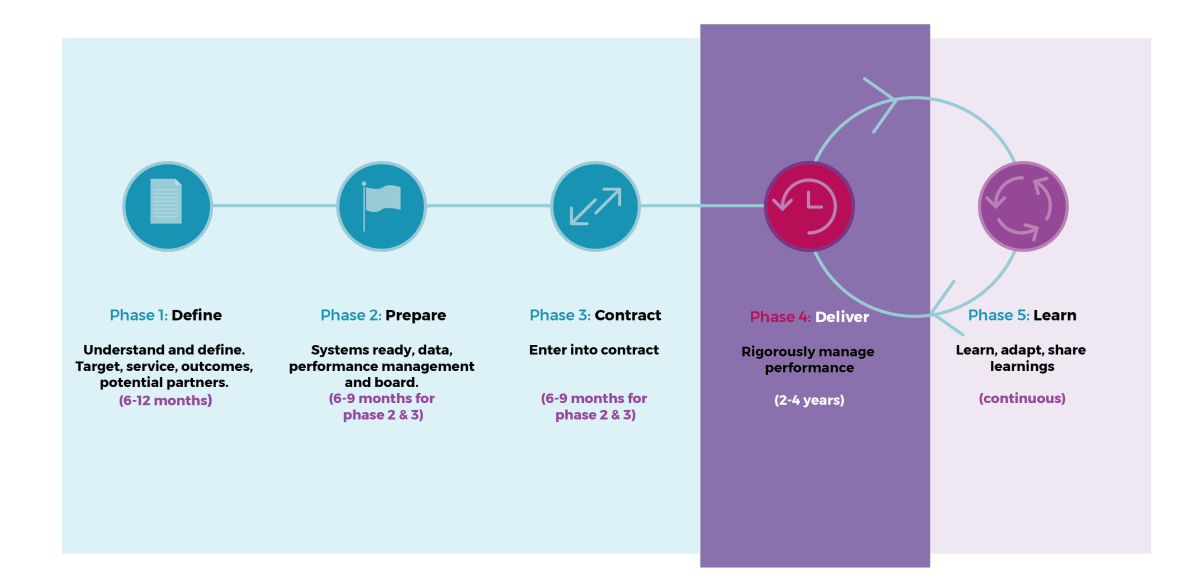In Phase 1, you set yourself up for successful performance management by mapping out the logic between the beginning of your intervention and the final outcome, with all the steps in between. You can use this model or map throughout the delivery process to tell if you’re on track to deliver your final outcome. All staff involved with the SIB need to feed into, understand, and continuously use this map throughout the programme.
In order to effectively manage performance you need to:
Quality Assurance
Data and databases can often absorb most of the time given to performance management, but quality assurance is particularly important in a SIB, where delivery will often have been scaled rapidly, and where success depends on consistency.
You will have made outcomes projections for your scenario modelling based on past performance and any other evidence available about the effectiveness of your programme. To join up the circle, you now need to ensure that what is being delivered matches what was designed.
Quality assurance activities can include:
- File audits (e.g. checking consent forms and other documentation is in place)
- Procedure compliance (e.g. safeguarding spot checks)
- Programme design compliance (e.g. checking numbers of activities delivered)
- Programme quality checks (e.g. observation of delivery)
- Feedback gathering (e.g. participant survey)
Gathering feedback

Qualitative feedback advice:
Feedback questions should be designed to get at the 'mechanisms for change' – the point where the activity yields an outcome. Too often they're not - they are getting at something unrelated - for example, 'would you recommend us?' or 'did you enjoy the programme?'. You should be using a validated and standardised measure - don't try to design questionnaires yourself.
– Independent evaluation provider
The art of quality assurance lies in:
- How these activities are built into the regular calendar without disrupting delivery, and
- how the results are communicated and assimilated. Do they feed into personal training plans? Newsletter case studies? Governance reports?
If the SIB’s outcomes and overall performance is suffering, the answer may well lie in something discovered during quality assurance.
Tools
Self-Assessment Tool
by The Matrix Standard
Download Tool
Before quality assurance can take place, the delivery team needs to be clear ‘what good looks like’. Staff, ideally in partnership with beneficiaries, need to define quality markers. For example, a certain workshop needs to be delivered with empathy, with energy, and in a safe space. Everyone needs to be aware of these markers and the fact that they will be monitored. Look at accredited standards for your sector, like the Matrix quality standards, for inspiration.
Quality Assurance Activities
Contributed by Maximus
Download Tool
This tool offers the building blocks for a Quality Assurance Framework. It proposes tiered quality assurance activities at different levels within an organisation, and the elements for a framework to surround them.
Sample Quality Assurance Calendar
Contributed by Maximus
Download Tool
This is one example of an intermediary organisation’s quality calendar, and gives an idea of what happens daily, weekly, monthly and annually to ensure a high quality of delivery.
External performance management support
You’ll need to decide whether or not to outsource performance management.Outsourcing performance management offers some advantages over managing it in-house, notably reducing the burden on a delivery organisation which may be overstretched, especially if the performance management system needs to be built from scratch. However, it has drawbacks:
- As well as carrying a cost, outsourcing creates the risk that the performance management process becomes disconnected from the delivery team and too focused on the board and the commissioner without the necessary feedback loops between the two
- It also means that they organisation does not develop the internal capacity to carry out this important function
To reconcile these factors, a common arrangement is to only outsource the function for the beginning of the programme. Over time, the person or team responsible for performance management may be integrated into the organisation, with the budget expanding to include their salary, so that the organisation expands its internal capacity to include performance management. Another option is that the external person trains up internal staff and then moves on.
If you decide to outsource performance management at any point, you will need to allocate internal capacity to manage this resource.
Working with external performance management support
If you have external performance management support, take steps to internalise their best practices at analysis and decision-making, and to disseminate these learnings to your team in real time.
Case study: Performance Management on the Energise SIB
Adviza and Social Finance worked together on the Energise DWP SIB, which required a great deal of data to be collected from 42 schools across Berkshire, Buckinghamshire and Oxfordshire.
The challenge was facilitated by a model tracking the flow of young people through the programme, along with the required levels of contact at each stage of engagement. The young people’s progress and participation were tracked weekly, highlighting where provision needed to be modified as well as predicting resource requirements month to month.
The performance management approach helped to ensure that the programme was achieving target outcomes and was collaborative. The model was refined along the way to include extra referral information and was used to promote the programme among schools. Adviza had a strong track record of collecting operational data and monitoring performance. The performance management approach from the SIB built on this to facilitate data-based decision-making, and the use of rigorous measurement across its other programmes.

